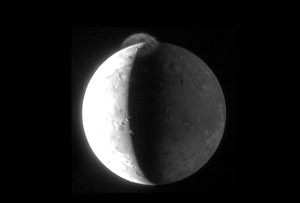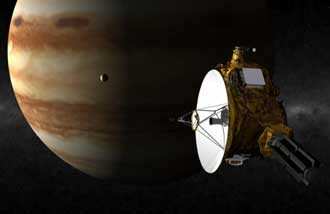But No Sign Of Monolith, Clarke Fans...
 NASA reports its Pluto-bound New
Horizons spacecraft has provided new data on the Jupiter system,
stunning scientists with never-before-seen perspectives of the
giant planet's atmosphere, rings, moons and magnetosphere.
NASA reports its Pluto-bound New
Horizons spacecraft has provided new data on the Jupiter system,
stunning scientists with never-before-seen perspectives of the
giant planet's atmosphere, rings, moons and magnetosphere.
These new views include the closest look yet at the Earth-sized
"Little Red Spot" storm churning materials through Jupiter's cloud
tops; detailed images of small satellites herding dust and boulders
through Jupiter's faint rings; and of volcanic eruptions and
circular grooves on the planet's largest moons.
As Aero-News reported, New
Horizons came to within 1.4 million miles of Jupiter on February
28, using the planet's gravity to trim three years from its travel
time to Pluto. For several weeks before and after this closest
approach, the piano-sized robotic probe trained its seven cameras
and sensors on Jupiter and its four largest moons, storing data
from nearly 700 observations on its digital recorders and gradually
sending that information back to Earth.
"Aside from setting up our 2015 arrival at Pluto, the Jupiter
flyby was a stress test of our spacecraft and team, and both passed
with very high marks," said Science Mission Directorate Associate
Administrator and New Horizons Principal Investigator Alan Stern,
NASA Headquarters, Washington. "We'll be analyzing this data for
months to come; we have collected spectacular scientific products
as well as evocative images."
Images include the first close-up scans of the Little Red Spot,
Jupiter's second-largest storm, which formed when three smaller
storms merged during the past decade. The storm, about half the
size of Jupiter's larger Great Red Spot and about 70 percent of
Earth's diameter, began turning red about a year before New
Horizons flew past it. Scientists will search for clues about how
these systems form and why they change colors in their close
observations of materials spinning within and around the nascent
storm.
Under a range of lighting and viewing angles, New Horizons also
grabbed the clearest images ever of the tenuous Jovian ring system.
In them, scientists spotted a series of unexpected arcs and clumps
of dust, indicative of a recent impact into the ring by a small
object. Movies made from New Horizons images also provide an
unprecedented look at ring dynamics, with the tiny inner moons
Metis and Adrastea appearing to shepherd the materials around the
rings.
"We're starting to see that rings can evolve rapidly, with
changes detectable during weeks and months," said Jeff Moore, New
Horizons Jupiter Encounter science team lead from NASA Ames
Research Center, Moffett Field, CA. "We've seen similar phenomena
in the rings of Saturn."
Of Jupiter's four largest moons, the team focused much attention
on volcanic Io, the most geologically active body in the solar
system. New Horizons' cameras captured pockets of bright, glowing
lava scattered across the surface; dozens of small, glowing spots
of gas; and several fortuitous views of a sunlit umbrella-shaped
dust plume rising 200 miles into space from the volcano Tvashtar,
the best images yet of a giant eruption from the tortured volcanic
moon.

Already the fastest spacecraft ever launched, New Horizons
reached Jupiter 13 months after lifting off from Cape Canaveral in
January 2006. The flyby added 9,000 miles per hour, pushing New
Horizons past 50,000 miles per hour and setting up a flight by
Pluto in July 2015.
The number of observations at Jupiter was twice that of those
planned at Pluto. New Horizons made most of these observations
during the spacecraft's closest approach to the planet, which was
guided by more than 40,000 separate commands in the onboard
computer.
 NTSB Final Report: Cozy Cub
NTSB Final Report: Cozy Cub ANN FAQ: Contributing To Aero-TV
ANN FAQ: Contributing To Aero-TV Classic Aero-TV: Seated On The Edge Of Forever -- A PPC's Bird's Eye View
Classic Aero-TV: Seated On The Edge Of Forever -- A PPC's Bird's Eye View ANN's Daily Aero-Linx (04.29.25)
ANN's Daily Aero-Linx (04.29.25) ANN's Daily Aero-Term (04.29.25): Execute Missed Approach
ANN's Daily Aero-Term (04.29.25): Execute Missed Approach




